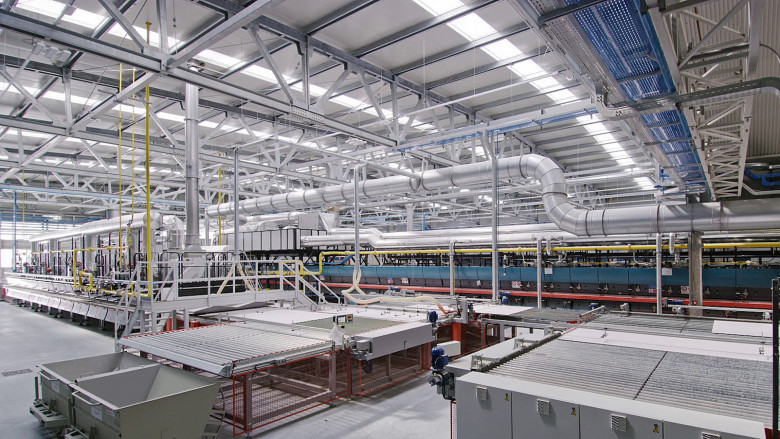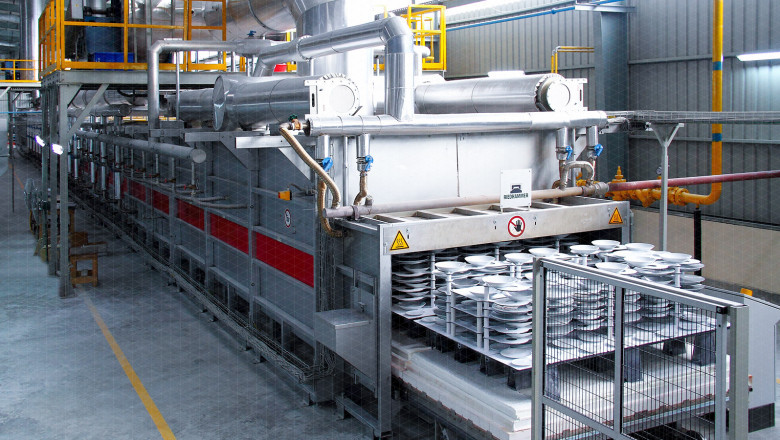views
The Role of Artificial Intelligence in Enhancing Ceramic Manufacturing Efficiency

Introduction:
The Ceramic Machinery Market has long been an essential part of the global manufacturing sector, providing a wide array of products that serve critical applications in construction, automotive, electronics, and healthcare industries. As the demand for high-quality ceramic products continues to rise, manufacturers are increasingly turning to innovative solutions to enhance their production processes. Among these solutions, Artificial Intelligence (AI) has emerged as a transformative force in ceramic manufacturing, significantly improving efficiency, productivity, and product quality.
In recent years, the integration of AI technologies into ceramic machinery has paved the way for new advancements in automation, precision, and predictive maintenance. AI-driven systems are helping manufacturers streamline operations, reduce energy consumption, and minimize waste, all while delivering superior products that meet evolving consumer demands. This article explores the role of Artificial Intelligence in enhancing ceramic manufacturing efficiency and how it is revolutionizing the ceramic machinery market.
The Growing Importance of AI in Manufacturing
AI refers to the development of computer systems that can perform tasks that traditionally require human intelligence, such as problem-solving, decision-making, and pattern recognition. In manufacturing, AI applications are primarily focused on improving automation, enhancing data analysis, and enabling more intelligent decision-making.
AI is becoming a key enabler of Industry 4.0, the current trend of automation and data exchange in manufacturing technologies. With the integration of AI, manufacturing processes can be optimized for speed, cost, and precision, leading to improved operational efficiency, higher-quality output, and reduced environmental impact. The ceramic industry, with its complex production processes, has been quick to adopt AI to address these challenges and enhance efficiency at every stage of production.
AI Applications in Ceramic Manufacturing
AI is being deployed across various stages of ceramic manufacturing to improve process control, increase production rates, and reduce costs. Below are some of the key areas where AI is having a significant impact:
1. Automation of Production Lines
One of the most prominent applications of AI in ceramic manufacturing is the automation of production lines. The traditional ceramic manufacturing process involves a series of time-consuming and labor-intensive steps, including mixing, molding, pressing, glazing, and firing. AI-driven robotic systems are now being used to automate many of these processes, reducing the need for manual labor and improving efficiency.
For example, robotic arms equipped with AI-powered vision systems can handle delicate tasks such as sorting, stacking, and packing ceramic tiles with high precision and speed. These robots can be programmed to adapt to different product sizes, shapes, and designs, making them highly versatile and efficient in large-scale manufacturing environments. Automation not only reduces labor costs but also helps manufacturers meet rising demand while maintaining consistent quality across their products.
2. Predictive Maintenance and Downtime Reduction
Another significant area where AI is making an impact is in predictive maintenance. In traditional manufacturing environments, machinery breakdowns and unplanned downtime can lead to substantial losses in production capacity and increased maintenance costs. By integrating AI into ceramic machinery, manufacturers can predict when equipment is likely to fail and take corrective actions before a breakdown occurs.
AI-powered predictive maintenance systems use sensors and machine learning algorithms to monitor the health of critical equipment, such as kilns, presses, and glazing machines. These systems continuously collect data on parameters like temperature, pressure, vibration, and wear levels, analyzing the data to detect patterns and identify early warning signs of potential failures. By predicting when maintenance is needed, manufacturers can schedule repairs during planned downtime, reducing unplanned interruptions and minimizing production losses.
This predictive approach to maintenance not only improves equipment reliability but also extends the lifespan of machinery, leading to long-term cost savings.
3. Quality Control and Defect Detection
AI is also playing a crucial role in quality control within ceramic manufacturing. Traditional quality control methods often rely on human inspectors to identify defects in products, which can be time-consuming and subjective. AI-driven vision systems, on the other hand, are capable of inspecting ceramic products with greater speed and accuracy, ensuring that only the highest-quality products reach the market.
Machine learning algorithms are trained to identify defects such as cracks, surface imperfections, or dimensional deviations by analyzing high-resolution images of ceramic products. These AI systems can inspect thousands of products in a fraction of the time it would take a human inspector, detecting even the smallest defects that may go unnoticed by the human eye.
Furthermore, AI can provide real-time feedback to operators, allowing for immediate adjustments to the production process to address any quality issues. By incorporating AI into quality control, manufacturers can significantly reduce defects, improve product consistency, and enhance customer satisfaction.
4. Process Optimization and Efficiency
In ceramic manufacturing, optimizing production processes is critical to reducing costs and improving efficiency. AI can analyze large volumes of data generated during production to identify inefficiencies and recommend improvements in the process.
For example, AI algorithms can analyze the firing process in ceramic kilns, optimizing factors such as temperature, airflow, and fuel consumption to minimize energy use and reduce CO2 emissions. AI systems can also optimize the glaze application process, ensuring that the right amount of glaze is applied to each ceramic piece, reducing waste and ensuring consistent coverage.
By continuously analyzing and adjusting production parameters in real-time, AI helps manufacturers fine-tune their processes to maximize output, reduce energy consumption, and minimize material waste. This level of optimization not only improves efficiency but also contributes to more sustainable manufacturing practices.
5. Supply Chain and Inventory Management
AI is transforming supply chain management in the ceramic industry by improving inventory forecasting, demand planning, and logistics optimization. By analyzing historical data, market trends, and external factors such as weather patterns or economic conditions, AI algorithms can accurately predict future demand for ceramic products, helping manufacturers plan production schedules and maintain optimal inventory levels.
AI-driven inventory management systems can also automate the ordering process, ensuring that raw materials and finished products are always available when needed. This reduces the risk of stockouts, overstocking, and production delays, contributing to smoother operations and improved customer satisfaction.
Moreover, AI can optimize logistics by identifying the most efficient routes for transporting raw materials to production facilities and finished products to customers. This reduces transportation costs and minimizes carbon emissions, contributing to the overall sustainability of the supply chain.
The Benefits of AI in Ceramic Manufacturing
The integration of AI into ceramic manufacturing offers a wide range of benefits for manufacturers, including:
1. Increased Production Efficiency
By automating key processes, predicting maintenance needs, and optimizing production parameters, AI helps manufacturers increase production efficiency. This leads to higher output with lower operational costs, enabling manufacturers to meet growing demand while maximizing profitability.
2. Enhanced Product Quality
AI-driven quality control systems ensure that ceramic products meet the highest quality standards by detecting defects and inconsistencies early in the production process. This reduces the likelihood of defective products reaching customers, improving brand reputation and customer satisfaction.
3. Reduced Operational Costs
AI helps manufacturers reduce operational costs by optimizing energy usage, minimizing material waste, and improving supply chain efficiency. These cost savings can be reinvested in further innovation and growth.
4. Improved Sustainability
AI’s ability to optimize energy usage, reduce waste, and improve supply chain efficiency contributes to more sustainable manufacturing practices. By minimizing the environmental impact of ceramic production, manufacturers can meet sustainability goals while remaining competitive in the market.
Challenges and Future Outlook
While AI offers numerous advantages, its implementation in ceramic manufacturing does come with certain challenges. These include the high initial costs of AI integration, the need for specialized skills to manage and operate AI systems, and potential resistance to change from workers accustomed to traditional manufacturing processes.
However, as AI technologies continue to evolve and become more affordable, the adoption of AI in ceramic manufacturing is expected to grow. The future of AI in the ceramic industry looks promising, with continued advancements in machine learning algorithms, robotics, and data analytics paving the way for even more efficient and sustainable manufacturing processes.
Conclusion
Artificial Intelligence is playing a transformative role in enhancing the efficiency of ceramic manufacturing. From automating production lines and optimizing processes to improving quality control and predictive maintenance, AI is helping manufacturers streamline operations, reduce costs, and produce higher-quality products. As the ceramic industry continues to evolve, the adoption of AI technologies will remain a key driver of innovation, improving the competitiveness and sustainability of manufacturers worldwide. The integration of AI into ceramic machinery is set to revolutionize the industry, bringing new levels of efficiency, productivity, and sustainability to the production process.






















Comments
0 comment